| Authors: | Alejandro Valdecantos (CEAM),V. Ramón Vallejo (UB), Susana Bautista (UA), Matthijs Boeschoten (UU), Michalakis Christoforou (CUT), Ioannis N. Daliakopoulos (TUC), Oscar González-Pelayo (UAVR), Lorena Guixot (UA), J. Jacob Keizer (UAVR), Ioanna Panagea (TUC), Gianni Quaranta (UNIBAS), Rosana Salvia (UNIBAS), Víctor Santana (UAVR), Dimitris Tsaltas (CUT), Ioannis K. Tsanis (TUC) |
| Editor: | Jane Brandt |
| Source document: | Valdecantos, A. et al. (2016) Report on the restoration potential for preventing and reversing regime shifts. CASCADE Project Deliverable 5.2 104 pp |
- The lack of areas with similar biophysical properties and land use histories that underwent any kind of restoration action in the past impeded to fully apply the ecosystem service protocol
- The two restoration plots found included the transformation of overgrazed areas to carob tree orchards
- Contrary to expected, interpatch cover and size were enhanced in the restored areas but the cover of bare soil was reduced as compared to the overgrazed degraded areas
- The Melidochori approach significantly improved the infiltration index from the degraded lands while the Odigitria restoration enhanced the nutrient cycling
- Plant cover, diversity and biomass data are needed to fully calculate regulating ecosystem services.
Plant cover, diversity indexes and biomass estimation (above and belowground and litter) are not yet available for the two restored sites in Messara. The assessment is therefore based just of Landscape Function Analysis variables and derived indexes.
Melidochori
The contribution of the interpatches in the Restored plot is higher than in the other three states of the ecosystem (Figure 1). The high heterogeneity of, especially, the Reference and the Semi-Degraded plots prevented significant differences of interpatch length but not of the cover. However, the total interpatch cover in the restored plot was equally distributed into litter and bare soil interpatches while both in the Reference and the Degraded plots bare soil contributed to more than 60% of the respective interpatches.
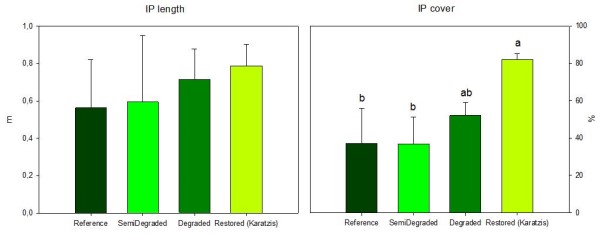

Similarly, patches were smaller, especially their average width, in the Restored plot than in the other three states (Figure 2). These data are deceptive because, in reality, there are larger patches of vegetation but not on the ground but in the canopy of the carob trees.
The combination of the soil surface assessment and spatial contribution of patches and interpatches resulted in LFA indexes not different among ecosystem states (Figure 3). Restoration improved the infiltration index in relation to the Degraded areas from 24.9% to 30.9% and was also even higher than the observed index in the Reference (29.3%). On the other hand, the highest reduction was perceived in the nutrient cycling as compared to the Reference but it was not so sharp in relation to the Degraded (from 22.2 to 19.3%).
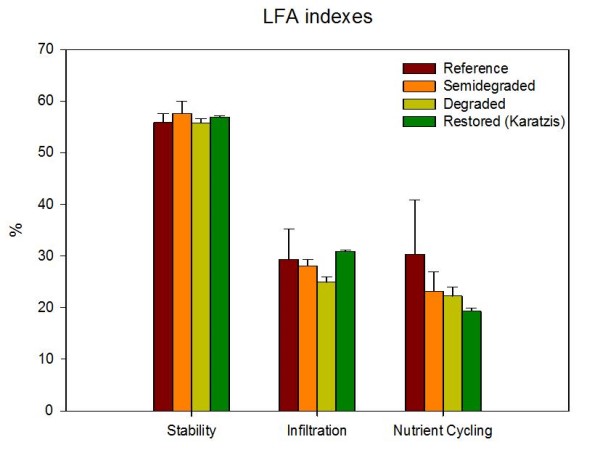
Odigitria
The percentage of the land corresponding to interpatches in the Odigitria restored plot was slightly lower than in the Degraded areas and rather similar to the Reference and the Semi-Degraded ones (Figure 4). However, the restored plot showed the longest interpatches (1.1 m vs 0.7 m in the Degraded) although differences were not significant. Interpatches in Odigitria were constituted by a mixture of grasses, stones and bare soil.
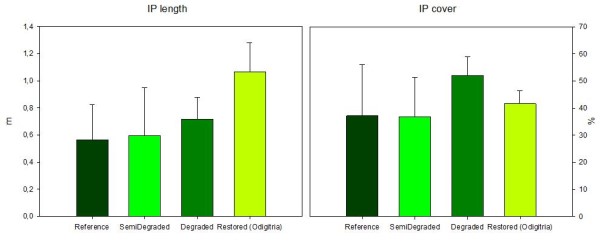
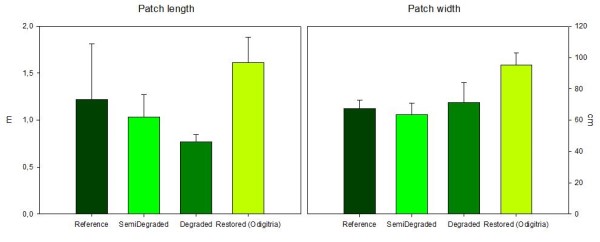
Patches in the restored plot averaged 1.61 m long and 0.95 m wide (Figure 5) and were mainly constituted by shrubs and subshrubs (24.5 and 22.5% of the total surface area, respectively). The Degraded plots showed smaller patches (0.77 m long and 0.71 m wide) with lower proportion of shrubs (18.0%) and slightly higher cover of subshrubs (27.9%, mainly the unpalatable species Urginea maritima). The Reference plots showed the highest diversity of patch types where shrubs were the most abundant (33.8%) followed by subshrubs (15.2%) and tussock grasses (10.0%).
LFA indexes in Odigitria restoration showed some differences to the restoration in Melidochori. Stability and infiltration did not change in relation to the Degraded plots while nutrient cycling was slightly improved (from 22.2 to 26.6%; Figure 6). The Reference released the highest values for both infiltration and nutrient cycling indexes while the stability was highest in the Semi-Degraded.
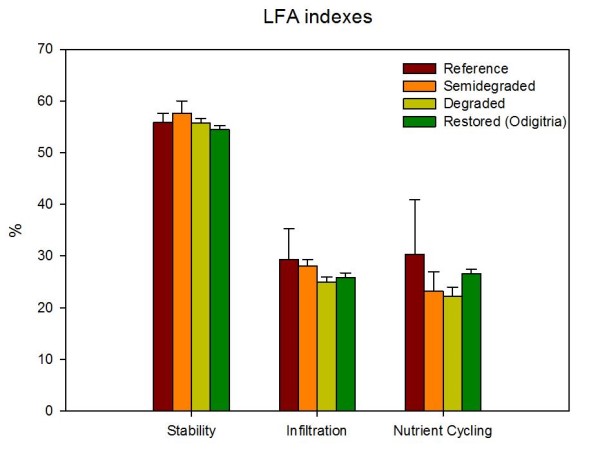
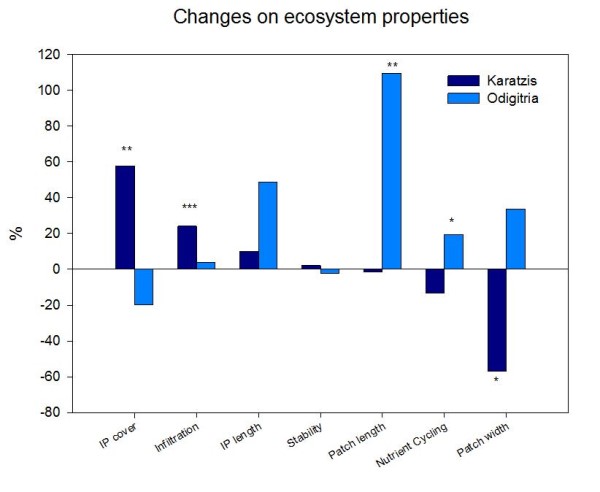
In general, most of the ecosystem properties evaluated through the LFA assessment were improved with restoration, especially with the Odigitria approach (Figure 7). The perceived significant increase of interpatch cover and length cannot be seen as positive changes.
Note: For full references to papers quoted in this article see
